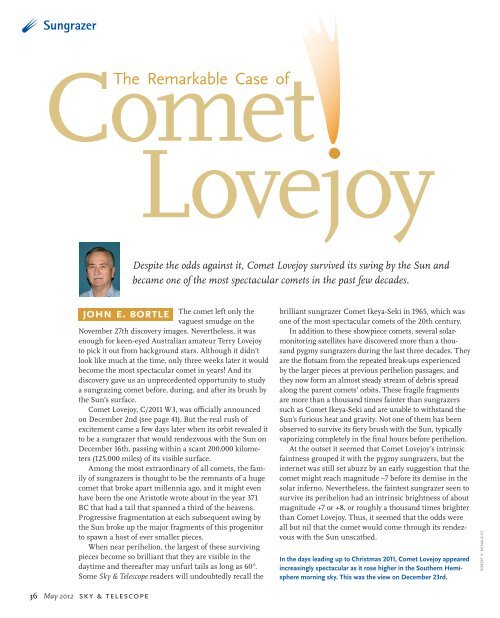Download this ebook as PDF - E-Book Library
Download this ebook as PDF - E-Book Library
Download this ebook as PDF - E-Book Library
You also want an ePaper? Increase the reach of your titles
YUMPU automatically turns print PDFs into web optimized ePapers that Google loves.
Sungrazer<br />
Comet<br />
The Remarkable C<strong>as</strong>e of<br />
Lovejoy<br />
36 May 2012 sky & telescope<br />
Despite the odds against it, Comet Lovejoy survived its swing by the Sun and<br />
became one of the most spectacular comets in the p<strong>as</strong>t few decades.<br />
john e. bortle The comet left only the<br />
vaguest smudge on the<br />
November 27th discovery images. Nevertheless, it w<strong>as</strong><br />
enough for keen-eyed Australian amateur Terry Lovejoy<br />
to pick it out from background stars. Although it didn’t<br />
look like much at the time, only three weeks later it would<br />
become the most spectacular comet in years! And its<br />
discovery gave us an unprecedented opportunity to study<br />
a sungrazing comet before, during, and after its brush by<br />
the Sun’s surface.<br />
Comet Lovejoy, C/2011 W3, w<strong>as</strong> offi cially announced<br />
on December 2nd (see page 41). But the real rush of<br />
excitement came a few days later when its orbit revealed it<br />
to be a sungrazer that would rendezvous with the Sun on<br />
December 16th, p<strong>as</strong>sing within a scant 200,000 kilometers<br />
(125,000 miles) of its visible surface.<br />
Among the most extraordinary of all comets, the family<br />
of sungrazers is thought to be the remnants of a huge<br />
comet that broke apart millennia ago, and it might even<br />
have been the one Aristotle wrote about in the year 371<br />
BC that had a tail that spanned a third of the heavens.<br />
Progressive fragmentation at each subsequent swing by<br />
the Sun broke up the major fragments of <strong>this</strong> progenitor<br />
to spawn a host of ever smaller pieces.<br />
When near perihelion, the largest of these surviving<br />
pieces become so brilliant that they are visible in the<br />
daytime and thereafter may unfurl tails <strong>as</strong> long <strong>as</strong> 60°.<br />
Some Sky & Telescope readers will undoubtedly recall the<br />
brilliant sungrazer Comet Ikeya-Seki in 1965, which w<strong>as</strong><br />
one of the most spectacular comets of the 20th century.<br />
In addition to these showpiece comets, several solarmonitoring<br />
satellites have discovered more than a thousand<br />
pygmy sungrazers during the l<strong>as</strong>t three decades. They<br />
are the fl otsam from the repeated break-ups experienced<br />
by the larger pieces at previous perihelion p<strong>as</strong>sages, and<br />
they now form an almost steady stream of debris spread<br />
along the parent comets’ orbits. These fragile fragments<br />
are more than a thousand times fainter than sungrazers<br />
such <strong>as</strong> Comet Ikeya-Seki and are unable to withstand the<br />
Sun’s furious heat and gravity. Not one of them h<strong>as</strong> been<br />
observed to survive its fi ery brush with the Sun, typically<br />
vaporizing completely in the fi nal hours before perihelion.<br />
At the outset it seemed that Comet Lovejoy’s intrinsic<br />
faintness grouped it with the pygmy sungrazers, but the<br />
internet w<strong>as</strong> still set abuzz by an early suggestion that the<br />
comet might reach magnitude –7 before its demise in the<br />
solar inferno. Nevertheless, the faintest sungrazer seen to<br />
survive its perihelion had an intrinsic brightness of about<br />
magnitude +7 or +8, or roughly a thousand times brighter<br />
than Comet Lovejoy. Thus, it seemed that the odds were<br />
all but nil that the comet would come through its rendezvous<br />
with the Sun unscathed.<br />
In the days leading up to Christm<strong>as</strong> 2011, Comet Lovejoy appeared<br />
incre<strong>as</strong>ingly spectacular <strong>as</strong> it rose higher in the Southern Hemisphere<br />
morning sky. This w<strong>as</strong> the view on December 23rd.<br />
ROBERT H. MCNAUGHT


